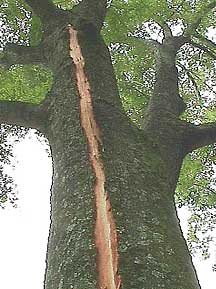© 2011 Naturesfury.net


Do you know what to do if you are caught in the open during a thunderstorm or you feel tingling or your hair standing on end? Lightning causes around 100 deaths in the U.S. annually (more than hurricanes and tornadoes combined).
In this picture the young woman and her friends were severely injured by lightning just a few seconds after this picture was taken. Notice that no rain was falling, clearly illustrating that lightning can strike up to several miles away from the thunderstorm.
NOAA Photo

Determine the danger:
If you are outdoors when you see or hear a thunderstorm coming or your hair stands on end, immediately stop your activities and seek safe shelter immediately!
Flash-to-bang:
- When you see the FLASH
- Count the seconds to the BANG
- Every 5 seconds equals 1 mile. Divide by 5 to give the distance in miles from you to the lightning.
- 30 seconds - suspend all outdoor activities (lightning strike was 6 miles away or less) and seek safe shelter
- If you count 15 seconds or less, a lightning strike could occur where you are (3 miles away or less).
Outdoor safety:
- Postpone outdoor activities if thunderstorms are imminent.
- Move to a sturdy enclosed building.
- Get inside a hardtop vehicle and keep the windows rolled up. Avoid touching any metal.
If caught outdoors and no shelter is nearby:
- Stay away from tall trees. If there is no shelter crouch in the open, keeping twice as far away from a tree as it is tall.
- Avoid being the tallest object around. Get as low as you can but do not lie prone on the ground. Squat on the balls of your feet to have minimum contact with the ground. Place your hands over your ears and your head between your knees.
- Get below tree line if you are in the mountains and into a grove of SMALL trees.
- Toss metal golf clubs, fishing rods, tennis rackets, tools, walking sticks, backpacks with metal or any other metal objects away from you. You can be burned by them.
- Get out of the water. If caught in a boat, crouch down in the center of the boat away from metal hardware. Swimming, wading, snorkeling and scuba diving are NOT safe. Don't stand in puddles, even if wearing rubber boots.
- Move away from a group of people. Stay several yards away from each other. Don't share a bleacher bench or huddle in a group.
- Avoid open fields, high places, trees (especially isolated trees), water, unprotected gazebos or picnic shelters, baseball dugouts, communications towers, flag poles and light poles, metal or wood bleachers, metal fences, convertibles, golf carts, bicycles, and motorcycles.
Indoor safety:
Utility lines and metal pipes can conduct electricity.
- Do not use any electrical appliances (except those used for weather information) and unplug unnecessary ones.
- Turn off air conditioners and computers to protect them from power surges.
- Do not use a corded telephone except in an emergency.
- Do not bathe or shower during a thunderstorm.
- Avoid contact with anything that conducts electricity
- Stay away from windows and doors.
- Avoid contact with concrete walls or floors which may contain metal reinforcing bars; carports or open garages; covered patios; washing your hands or doing dishes.
No place is completely safe from lightning, but some places are safer than others. Although some victims are struck directly by the main lightning stroke, many victims are struck as the current moves in and along the ground.

30/30 Rule
The first 30 means if, between flash and bang, you count to 30 or less, you are in danger and should go to safe shelter.
The second 30 means wait 30 minutes from the last flash or thunder to establish "all clear."
First Aid for Lightning Victims
Ninety percent of lightning victims survive their encounter with lightning, especially with timely medical treatment. Individuals struck by lightning do not carry a charge, and it is safe to touch them and provide medical treatment. Call 911 and start mouth-to-mouth resuscitation. If the victim has no pulse, begin cardiac compressions. In cold, wet situations put a protective layer between the victim and the ground to lower the risk of hypothermia.
